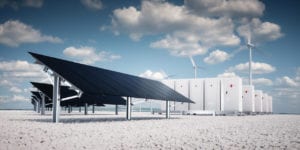A microgrid can be explained as a collection of electricity sources and sinks – or loads that operate with a traditional centralized grid (macro grid). A microgrid can also disconnect and function as a single entity – if needed – depending on the physical or economic condition.
According to the U.S. Department of Energy Microgrid Exchange Group, a microgrid can be defined as follows:
A microgrid is a group of interconnected loads and distributed energy resources within clearly defined electrical boundaries that acts as a single controllable entity with respect to the grid. A microgrid can connect and disconnect from the grid to enable it to operate in both grid-connected or island mode.
Microgrids in most cases are backed by generators or renewable wind and solar energy supplies. They are used as power backup in emergencies or aid the main power distribution grid during periods of heavy demand. A microgrid that includes local wind or solar resources can make the main grid less susceptible to any performance mishaps or hazards.
Buildings equipped by electric generation in the form of solar panels and contingency generators can also generate energy and revenue during downtime. By integrating smart grid deployments, excess energy can be sold back to local microgrid establishments to generate revenue, while also offering resilience and capacity to the local electrical grids.
A microgrid not only offers backup for the grid in case of emergencies and contingencies, it can also cut costs or connect to a local resource that is either too small or unreliable for traditional grid use. A microgrid enables communities to become more energy independent and environment-friendly. Microgrids come in varying sizes and capacities—from powering single, compact facility to large areas. Individuals can opt for cleaner, cheaper energy by installing solar panels on the roofs of their homes or by connecting to a local solar power management grid.
Private residents can regulate their own consumption in an effective manner using either a storage solution or an integrated heat and power generating system. As explained above, they can also sell surplus energy back to the main grid at a pre-defined tariff. #SchneiderElectric is a globally renowned brand entering the microgrid industry. #LifeIsOn.



Conversation
Yes – micro grids of power combined with “micro grids” of mobile networks (5G) is a combination one could discuss…